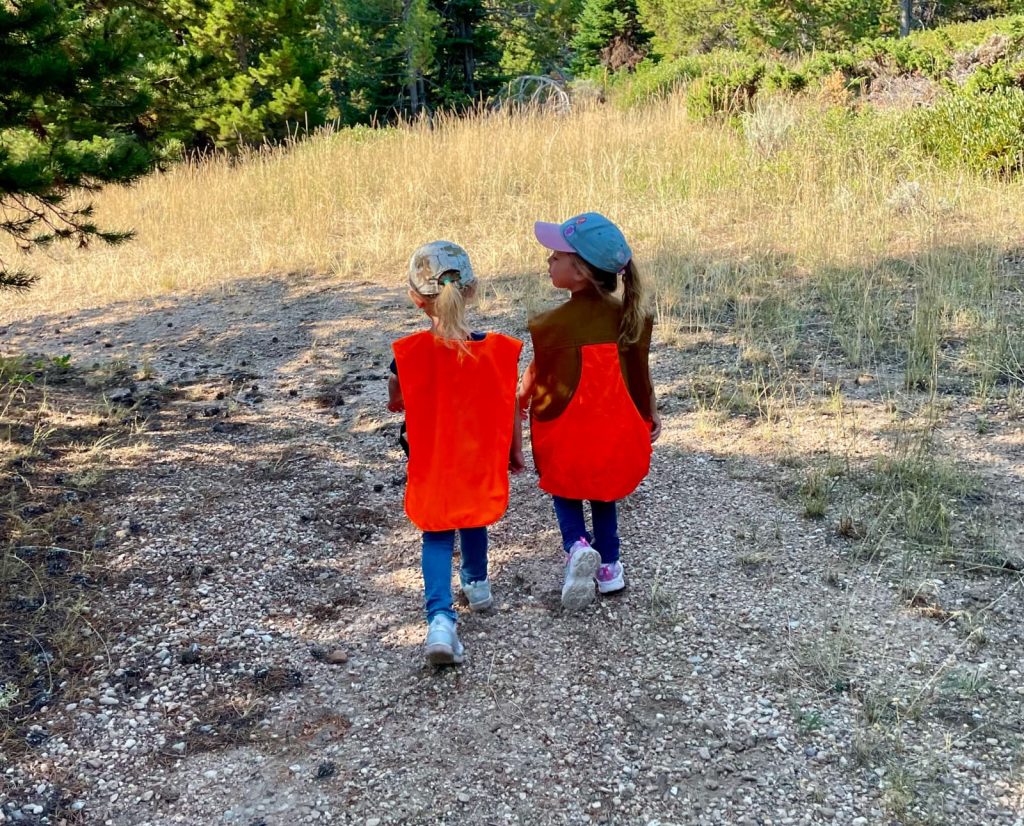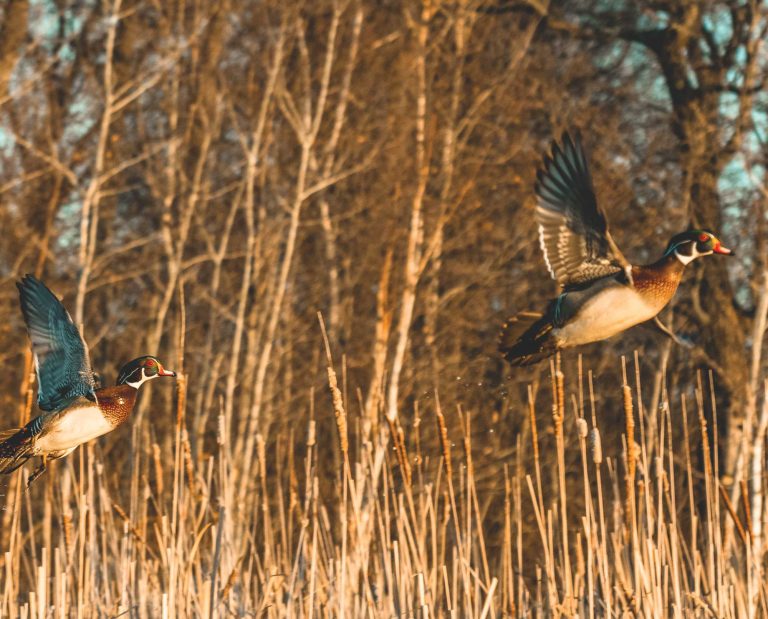Introducing Kids to Upland Bird Hunting

Guidance for teaching kids about bird hunting, bird dogs, and conservation.
My daughter was three and a half years old the first time she picked up a hen pheasant and cradled it in her arms like a baby. I remember patiently waiting with bated breath for her reaction. Would she balk when she realized it was not alive? Would she exclaim “ew” and hurry back inside? Or would she see it as a beautiful creature like I did?
When she looked down at it with pure admiration, gently stroked its feathers, and declared her love for it, I released my breath with a flood of relief. Witnessing that moment of connection filled my heart.
Like most parents, I hope my children will share my interests so we can enjoy them together. As a passionate upland hunter, I dream of days spent in the field nurturing their curiosity, instilling a desire for conservation, and fostering a profound respect and appreciation for the game birds we pursue. There’s a special kind of magic and responsibility involved with welcoming young children into the world of upland hunting.
I often get asked, “When is the right time?” I believe it depends on many factors, primarily age and maturity, but it’s important to understand there’s no one-size-fits-all introduction to the uplands.

Hunting With Young Children
I’ve taken many hunting trips with a child in a baby carrier, but if you are looking for active participation, that usually comes around ages five to seven. This is when kids are physically able to handle short walks in the field.
Children under ten usually observe rather than participate in hunting or shooting. As they grow older, between ages 10 and 13, they often find the desire to become more involved and may even do some hunting.
It may take a few years of just tagging along before your kids are ready to fully participate. In fact, I often encourage this approach. Every child is unique, and their disposition and personality often dictate how you should present a hunting experience to them. My daughter is a fearless go-getter who always wants to be in the thick of it, whatever “it” may be. My son, on the other hand, is more cautious and inquisitive. My son was about five when we took him on his first walkabout for blue grouse; my daughter, on the other hand, was just over three.
I find most children to be like young bird dogs – some develop more quickly than others, and all of them need patience. The only universal advice is that you should always strive to make it fun for them, even if it means making sacrifices on your end.
Just like dog training, proper introductions are crucial to building solid, long-lasting foundations, and poor experiences can turn them off for life. Developing a love for outdoor pursuits often starts with non-hunting activities, especially for younger children.
Parents, start small. Allow your child to sit with you and help plan hunting trips. Let them help you pack your bags. Take them on small hikes that gradually get longer to help build their leg endurance. Let them carry their own daypack, so they have some responsibility. Involve them in scouting and give them first-hand experience in identifying scat and bird signs. Build up to an overnight camping trip where they might have to experience being a little bored, being patient, and or changing weather conditions.
These ordinary outdoor experiences are the building blocks for future hunting adventures.

Leave Your Hunting Expectations At Home
When you and your child feel like you’re ready for that first upland trip, leave your expectations at home. Hunting with kids can be challenging and is usually not successful in the traditional sense.
Kids are loud, squirmy, and curious. They will ask a lot of questions. Answer those questions, even if it’s just about what snacks you’ll have. This first trip will not be about you, your dogs, or the birds. It will be about your child. The experience should be theirs, and you must be tagging along with them rather than them tagging along with you. Their positive experience matters the most. Redefine what a “successful” hunt means by focusing on bonding with your child.
To ensure an enjoyable experience, plan ahead. Don’t pick the hottest or the coldest day of the season. Don’t hunt the thickest cover you’ve ever seen. Certainly don’t take them out when six inches of snow covers the ground. Pick a day with pleasant weather. During the day, discuss your hunting plan, the game bird you’re looking for, what that bird looks like, where you might find it, and how the dogs will work. Remind them of what to do when you see a bird or a dog goes on point. Don’t make their first hunting trip about limits or even holding a gun. Instead, keep your first outings short, simple, and sweet.
Your primary goals during these outings are safety, learning, and fun. Keep them involved and engaged by letting them carry a bird. I’ve never known a child who didn’t want to keep a few feathers or intensely examine a bird’s crop. When appropriate, involve them in the care of the dogs, maintenance of equipment, or care of harvested birds. Work on building their confidence and encourage them to follow directions and engage in active listening.
Let Your Child Graduate From One Firearm To The Next
When the younger crowd is ready, let them tote around an unloaded Daisy Red Ryder. Older kids and preteens can manage a .22LR or a single-shot shotgun. Graduating from one youth-friendly gun to the next is a great way to level up their experience with carrying increasing weight.
When your child is ready to carry their own shotgun, prepare them for their first hunt by spending time target practicing with low recoil shells. Make the experience as fun as possible, and stop by the grocery store for items like watermelon, honeydew, and cantaloupes. These can be used as fun and exciting targets, helping them to get excited about shooting while minimizing the awareness of recoil. As a bonus, choosing melons over cans of soda provides an opportunity to discuss the importance of making environmentally friendly choices that are also beneficial for wildlife.
Once they are strong enough to swing their gun, it’s time to introduce them to clay targets. When they can manage to avoid a low-pointing muzzle and break a few clays, they’re ready for active upland hunting.
The Importance of Safety and Hunter Education
Regardless of age or ability, always start with safety before allowing a child into the field. Safety should be reinforced and reiterated every single time you take a child out for any outdoor adventure. Hunters’ safety and education are lifelong skills that must be consistently practiced. As their role model, you need to know all the rules and safety precautions and demonstrate them correctly every time, as they will emulate your actions.
Most states offer hunters’ safety courses through their wildlife management departments. These courses are often designed for a fourth-grade reading level, making them suitable for children ages ten and up. States usually offer both in-person and online courses to meet a variety of needs, but since children often learn best through hands-on experiences and have shorter attention spans, I highly recommend that children take a traditional in-person course.
Youth licensing fees and requirements vary from state to state, and many agencies have special rules and seasons for youth.
Entry-Level Bird Hunts Kids Will Enjoy
For a child’s first upland hunt, consider starting with pheasants at a local game preserve. Preserves often provide a more controlled environment, and, let’s face it, seeing birds is more of a sure thing. Flushes are typically easier to orchestrate, and the grounds provide easy walking. As the adult, you can focus on safety, watching the dogs, building anticipation, and boosting your child’s confidence while they engage in hunting and hopefully harvesting.
When your young wingshooter is ready for the world of wild birds, sage grouse and dusky grouse are great pursuits due to their size and, at least in Wyoming, their accessibility. Selecting game birds and situations where harvest is more likely increases their chances of obtaining success. Just as we give young bird dogs plenty of bird contacts and opportunities, the same should be afforded to kids.
Remember that your child’s size, physical capabilities, and maturity will determine the speed of their progress. Learn to read when they are losing interest, getting fatigued, or uncomfortable. Let them determine the pace and let them get involved as much or as little as they want. The trick to success lies in knowing when to say when.
As with all things, there is a delicate balance between sharing your passion, managing your children’s expectations, and not pressuring them to do something they don’t enjoy. It’s important to avoid getting too wrapped up in the nitty-gritty details. Kids should be allowed to have fun; otherwise, they won’t want to go again. Let them run wild and be present. If they spook a bird or two, no big deal – there will be plenty of other opportunities. Focus on giving lots of praise and minimal correction.
Are you seeing the pattern between kids and young bird dogs yet?

Investing In Proper Gear and Fun Activities
Invest in proper clothing to keep them comfortable, and consider getting youth-specific gear like their own bird vest to make their adventures with you more appealing. It’s also okay to splurge a little; stock up on snacks and drinks. Our family has a tradition of making trips special by stopping at the gas station before we leave for a drink and a candy bar. Tailgate parties are also a favorite–-grilling hot dogs and enjoying snacks is something every kid loves.
Nurturing Positive Outdoor Experiences
If your child decides they aren’t interested in hunting, it’s crucial to back off and not push. Allow them to experience the outdoors on their terms. As mentioned earlier, there are so many ways in which your child can participate, even if they aren’t directly interested in hunting. By keeping the door open for them to enjoy other aspects of the outdoor experience, they are more likely to consider hunting again later on.
It’s also perfectly fine to let them bring along items to keep them entertained during downtime or on the drive to and from the hunting location. While it might be tempting to ban tech on outdoor trips, this can unintentionally create resentment towards the activity you’re trying to encourage. Instead, consider tech-free times or make tech work in your favor.
Won’t give up the phone? Suggest they be the photographer for the day. Complaints of boredom? Give them their own walkie-talkie, let them mark waypoints on your hunt map, or have them manage one of the dog’s handhelds. Hunting with you doesn’t have to start with hunting birds.
From preparing for their first tag-along to harvesting their first bird and beyond, youth can learn valuable lessons in the field. Your child will develop respect for the land and the birds that call it home. They will learn to appreciate the hardworking dogs they follow, and the knowledge gained from being outdoors will sharpen their instincts and resourcefulness. They will learn patience, diligence, and discipline—all attributes that grow self-confidence. These lessons will last a lifetime.
It is my hope that this guidance encourages you to nurture your child’s curiosity, instill a desire for conservation, and foster a profound respect and appreciation for the game birds we pursue. Remember, just as with young bird dogs, while you might be in charge of the scheduling and planning, your kids will always determine the pace at which they learn. Buckle up and enjoy the ride–I promise it’s magical.









As an upland enthusiast and father, great article , very well written and every point is spot on! Love it!